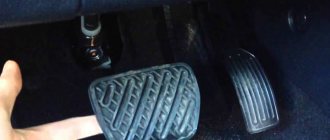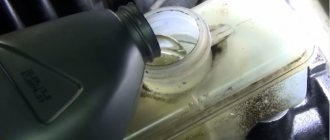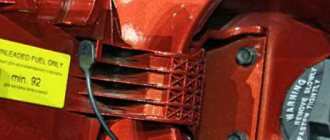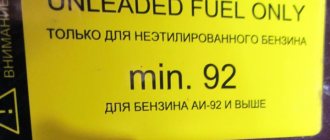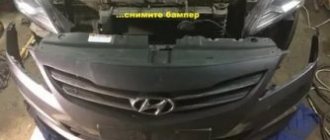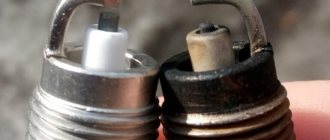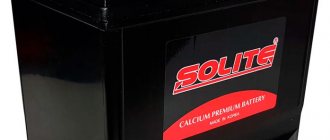For the safe operation of a Hyundai Solaris, the condition of the brake fluid is important. It should be changed promptly, following the manufacturer's recommendations for selection.
Carrying out the replacement will not be difficult with your own hands, but the car owner should still know some of the intricacies of the event.
The original Hyundai Brake Fluid is poured into the brake circuit of the Hyundai Solaris. It is sold under article number 0110000110. The volume of the canister is one liter, and the price ranges from 380 to 550 rubles. Branded brake fluid is classified as DOT-4.
Original brake fluid for Hyundai Solaris
It is allowed to fill the Hyundai Solaris brake system with fluid from third-party brands. As an alternative to the original, you can choose any technical specification that relates to DOT-4. The table below presents the best options from third-party companies that have gained wide popularity on the Hyundai Solaris.
Table - Good brake fluids for Hyundai Solaris
| Brand | vendor code | Estimated cost, ruble |
| VAG | B000750M2 | 290-390 |
| Polkar | VA402402 | 260-290 |
| Honda | 0820399938 | 550-590 |
| TRW | PFB450 | 120-260 |
| General Motors | 93160363 | 425-610 |
| Bosch | 1987479106 | 150-245 |
| ATE | 03990158012 | 155-175 |
| Brembo | L04005 | 145-165 |
| Peugeot/Citroen | 469934 | 500-550 |
Replacement frequency
Replacing brake fluid on Hyundai Solaris is required every 30 thousand km. At the same time, the TZ should be updated at least once every 2 years, regardless of the mileage the car has traveled.
In this case, an unscheduled replacement of the fuel tank may be required. The reasons for this are:
- periodic boiling of brake fluid;
- unpleasant odor that comes from the fuel tank;
- the tester shows increased moisture content;
- the volume of brake fluid has decreased;
- the walls of the tank began to become covered with plaque;
- there are flakes or other inclusions in the liquid;
- mechanical damage to the tank body or its lid; water or other technical fluid has entered the fuel fluid.
If you do not replace the brake fluid in a timely manner, a number of negative consequences are possible. The main ones are presented below:
- loss of the ability to stop the car due to boiling of the fuel tank;
- corrosion of metal surfaces of the brake circuit;
- souring of the piston in the cylinder and, as a result, the car pulling to the side when it stops;
- dependence of braking intensity on ambient temperature.
2272-6-12-02-02
Using a 10mm wrench, unscrew the bleeder fitting 1/2–3/4 turn.
In this case, liquid with air bubbles will flow out of the hose, and the brake pedal will move forward.
As soon as the liquid stops flowing out of the hose (the pedal should go all the way), tighten the fitting, and only after that can the assistant release the pedal.
We repeat pumping until the liquid coming out of the hose becomes light-colored. We remove the hose, wipe the bleeder fitting dry and put a protective cap on it.
Rules for replacing brake fluid
The fitting caps have a short lifespan. They often crack and lose elasticity. Therefore, it is advisable to have several caps in stock in order to quickly replace a worn or damaged element.
Connector caps
When draining the brake fluid, the correct sequence of opening the fittings should be taken into account. This will minimize the mixing of new and old fuel fluid. You can see the sequence of bleeding the brake circuit in the image below. The amount of fuel spent in this case is minimal.
Bleeding wheels with minimal mixing of old and new diesel fuel
Brake fluid is highly hygroscopic. Therefore, it is prohibited to use fuel oil that has been stored in an open container. The absorbed moisture significantly reduces the boiling threshold of the liquid. This increases the risk of brake failure during intense or emergency stopping of the vehicle.
The high hygroscopicity of brake fluid does not allow it to be reused after draining. For refilling, you should use only fresh fuel oil from a sealed container, for example, from a tightly closed canister.
Brake fluid contains components that make it toxic. To protect the environment, it is prohibited to discharge slurry into rivers, lakes or onto the ground. It is also not recommended to pour TJ into the sink or toilet. To ensure proper disposal, it must be taken to a toxic and hazardous waste collection point.
Brake fluid is aggressive not only to the environment, but also to the car’s paintwork. Pouring it onto the body can significantly damage the paintwork. Therefore, if TJ gets on the paintwork, it should be wiped off as soon as possible. After this, the spill area must be washed with water and car shampoo.
When changing brake fluid, avoid using rags containing lubricants. The oil reacts with the fuel fluid. As a result, the slurry loses its original properties and its use in a car significantly reduces driving safety.
What's already in the car?
The Korean auto giant releases its models from the assembly line, filling them with DOT-4 class fuel oil. Its manufacturer is not determined, it is marked as Hyundai/Kia 01100-00110 BRAKE FLUID.
It is not always possible to purchase a similar one for replacement, but here the car enthusiast has the opportunity to choose any brand if it meets the criteria applicable to the DOT-4 standard, regardless of the specific manufacturer.
You need to purchase the volume of liquid that will replenish the entire amount in the vehicle. This is approximately 1.25 liters. But if we take into account the volume that is located in the clutch drive, the total result is 1.75 liters.
Required Tools
To replace the TJ with a Hyundai Solaris, you need the tools from the table below.
Table - List of tools required to change brake fluid
| Tools | Note |
| Box or open-end wrench | "on 10" |
| Tara | Volume about 2 liters |
| Hose | Transparent |
| Jack | To lift the car |
| Balloon wrench | For wheel removal and installation |
| Rags | To clean dirt |
2272-4-13-03
After pumping out the old brake fluid, pour new brake fluid into the reservoir.
We carry out the replacement with the engine not running, first in one circuit, and then in the other in the following sequence:
- brake mechanism of the right rear wheel.
- brake mechanism of the left front wheel.
- left rear wheel brake.
- brake mechanism of the right front wheel.
We clean the bleeder fitting of the brake mechanism of the right rear wheel from dirt.
avtoexperts.ru
One of the most important fluids for normal vehicle operation. brake About why this fluid is needed, how often it needs to be changed, and what specific brake water to use for good operation of the car’s braking system. in our current article.
Classification of brake fluids
Now in most countries of the world there are Unified Brake Fluid Standards, known as DOT (after the name of the agency that developed them. Department of Transportation. Ministry of Transport of the United States of America). Such markings can often be found on packages of brake fluids. It means that the product is manufactured in accordance with the regulatory federal standards for vehicle safety FMVSS No. 116 and can be used in the brake systems of cars and trucks, depending on the technical features of THESE vehicles. In addition to the South American standard, brake fluids are marked in accordance with standards adopted in a number of European and Asian countries (ISO 4925, SAE J 1703 and others).
But they all systematize brake fluids according to two characteristics. their kinematic viscosity and boiling point. The first is responsible for the ability of working water to circulate in the brake system line (hydraulic drive, pipes) at the latest operating temperatures: from 40 to 100 degrees Celsius. 2nd. to prevent the formation of a vapor lock, which appears at high temperatures and can lead to the brake pedal NOT operating at the right moment. When systematizing the TS by boiling point, two of its states are distinguished. the boiling point of water without water impurities ("dry" TS) and the boiling point of water containing up to 3.5% water ("wet" TS). The “dry” boiling point of brake water is determined by new, just-filled working water, which has not had time to “collect” water and later has the highest performance characteristics. The “moistened” boiling point of the vehicle refers to working water, which has been in use for 2-3 years and contains a certain amount of water in its composition. Read more about this. in the section “Service Life of Brake Fluids”. Depending on THESE characteristics, all brake waters are divided into four classes.
DOT 3. The “dry” boiling point of this brake water is at least 205°, while the “wet” boiling point is. more than 140°. Kinematic viscosity of such a vehicle at 100°. less than 1.5 mm²/s, and at.40. more than 1500 mm²/s. The color of this brake water. yellow. Application: designed for use in cars whose highest speed is no more than 160 km/h, the braking system of which uses disc (on the front axle) and drum (on the rear axle) brakes.
DOT 4. The “dry” boiling point of this brake water is at least 230 °, while the “wet” boiling point is. more than 155°. Kinematic viscosity of such a vehicle at 100°. less than 1.5 mm²/s, and at.40. more than 1800 mm²/s. The color of this brake water. yellowish. Application: designed for use in vehicles whose maximum speed is up to 220 km/h. The braking system of such cars has disc (ventilated) brakes.
DOT 5. The “dry” boiling point of this brake water is at least 260°, while the “wet” boiling point is. more than 180°. Kinematic viscosity of such a vehicle at 100°. less than 1.5 mm²/s, and at.40. more than 900 mm²/s. The color of this brake water. red. Unlike the TCs indicated above, DOT 5 is based on silicone, not polyglycols. Application: created for use on special vehicles operating in extreme temperatures for brake systems, and later not used on ordinary passenger cars.
DOT 5.1. The “dry” boiling point of this brake water is at least 270 °, while the “wet” boiling point is. more than 190°. Kinematic viscosity of such a vehicle at 100°. less than 1.5 mm²/s, and at.40. more than 900 mm²/s. The color of this brake water. light brown and. Application: designed for use in brake systems of sports racing cars, in which the temperatures of working fluids reach critical values.
The role of brake fluid in the “organism” of a car
The braking system, which is responsible for stopping the car in a timely manner and later plays an important role for the safety of car passengers, cannot work without brake water (BR). It is this that performs the main function of the braking system. transmits the force from pressing the brake pedal to the wheel brake mechanisms through a hydraulic drive. pads and discs, causing the car to stop. Therefore, even in driving schools, novice car owners are constantly advised to periodically inspect the levels of 4 service fluids: engine oil, antifreeze, glass cleaner and brake water, on which the best operation of the car depends.
READ Replacing the Priora Brake Master Cylinder
Composition and properties of brake fluids
The basis of the chemical composition of most brake fluids is polyglycols (up to 98%), less often manufacturers use silicone (up to 93%). In brake fluids, which were used on Russian cars, the base was mineral (castor oil with alcohol in a 1: 1 ratio). The use of such waters in modern cars is not recommended due to their high kinetic viscosity (thickens at 20°) and low boiling point (more than 150°).
The remaining percentages in polyglycol and silicone vehicles are represented by various additives that improve the properties of the brake water base and perform a number of necessary functions, such as protecting the surfaces of working devices of the brake system or preventing oxidation of the vehicle as a result of exposure to high temperatures.
It is NOT in vain that we carefully stopped on the chemical composition of brake fluids used in cars, because many car owners are interested in the question. “Is it possible to combine TS with different chemical bases?” We answer: it is strictly not recommended to combine mineral waters for the braking system with polyglycol and silicone waters. The interaction of the mineral and synthetic bases of THESE fluids can create a clot of castor oil, which clogs the brake system lines, and this is fraught with defects in the brake system. If you mix mineral and polyglycol TC, then this “hellish mixture” will be absorbed into the surface of the rubber seals of the hydraulic brake parts, which will lead to their swelling and loss of sealing.
Although polyglycol vehicles have a similar chemical composition and can be interchangeable, it is still not recommended to combine them in one brake system. The fact is that each vehicle manufacturer can change the composition of additives at its own discretion, and mixing them can lead to a deterioration in the main performance characteristics of the working water. viscosity, boiling point, hygroscopicity (ability to absorb water) or lubricating parameters.
Silicone brake waters should not be combined with mineral and polyglycol waters, because as a result, the working environment becomes clogged with precipitated chemical substances, which will lead to clogging of the brake system lines and failure of the brake cylinder components.
When to change brake fluid?
The service life of brake water directly depends on its chemical composition.
Due to its own chemical characteristics (low hygroscopicity and good lubrication parameters), mineral TS has a fairly long service life (up to 10 years). But when water gets into the liquid, for example, in the case of depressurization of the brake system, its characteristics change (the boiling point drops, the viscosity increases), and it can no longer perform its functions, which can lead to brake failure. Repeated inspection (once a year) of the brake system and water conditions is recommended, which can be found in laboratory criteria.
Polyglycol TC has a medium or high degree of hygroscopicity. and later, her condition should be checked twice a year. You can assess the condition of the polyglycol vehicle visually: if the liquid has darkened or there are noticeable sediments in it, then it is necessary to completely replace it. Such a vehicle is capable of absorbing up to 3% of water per year. If this figure exceeds 8%, then the boiling point of the brake water may drop to 100 °, which will lead to boiling of the vehicle and failure of the entire brake system. Auto manufacturers advise changing polyglycol-based brake fluid every 40 thousand km or every 2-3 years. Usually such brake fluid is completely changed during the installation of new external brake devices (pads and discs).
Silicone TC is durable because its chemical composition is more resistant to external influences (water ingress). Typically, silicone brake fluids are replaced after 10-15 years from the date of filling into the brake system.
https://avtoexperts.ru/article/kakuyu-tormoznuyu-zhidkost-zalivat/
Finding out what antifreeze to pour into the Hyundai Solaris sedan: suitable options
When trying to find out what kind of antifreeze to fill in the Hyundai Solaris, you should contact the operation management. It correctly states that you can only pour Antifreeze diluted with distilled water. With all this, the coolant should be based on ethylene glycol and completely adaptable to an alloy radiator. Depending on the year of manufacture and place of assembly, the chemical composition of the solution varies:
For your information. Green pigment has been added to the waters listed.
The manufacturer filled the first Solaris models with Shell GlycoShell Longlife or Shell Premium Antifreeze coolant.
Briefly about the main thing
For anyone who is interested in what kind of antifreeze to pour into a Hyundai Solaris car, the advice is as follows:
- Hyundai Long Life Coolant (concentrate).
- Crown LLC A-110 / Coolstream A-110.
- Shell GlycoShell Longlife or Shell Premium Antifreeze.
In general, the plant suggests pouring in mixtures only based on ethylene glycol. According to WAG specification. this is G11.
Combining compositions of different colors is allowed. It is also allowed to combine formulations from different manufacturers. It is forbidden to mix cooling waters of different bases, in other words brands.
https://autostadt.su/antifreeze-dlja-hyundai-solaris/
Pointed question: what happens if you mix antifreeze of different brands and colors and the consequences
Before adding anything to the expansion tank, you should once again ask what brand of coolant is filled. After all, by mixing mixtures prepared on different bases, you can simply clog the channels of the engine cooling jacket.
Since the manual correctly states that the composition should be ethylene glycol, the product can only be topped up on this base. It is allowed to diversify by manufacturers and brands. under no circumstances.
READ 2022 Toyota Sequoia Is Here With Options And New Trims Galore
What happens if you connect? Everything is quite basic. Corrosion inhibitors are of different types; with their assistance, sediment or flakes may be released.
Many motorists struggle with the question: what if you mix antifreeze of different colors and what will happen after that? The answer is simple. nothing, as long as the base is the same. Generally speaking, there are standards for colors. Different companies use different pigments.
For your information. In the absence of Antifreeze, small additions into the Solaris expansion tank will completely drain distilled water (within the range of 100-500 ml).
adviсe
The nominal volume of the internal channels of the cooling system is 5.3 liters. Since the drain is done only from the radiator part and the expansion tank, coolant remains in the engine and heater radiator. Therefore, the amount of water is about 4 liters.
When changing the composition, an air lock may be created. If it has formed, and when the engine warms up, this will be indicated by the flow of cool air from the interior heating system, then you should stop the internal combustion engine and let it cool. After. Remove the radiator cap and start the engine for a couple of minutes. the air will come out.
